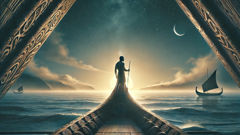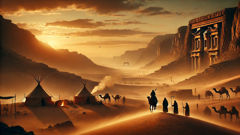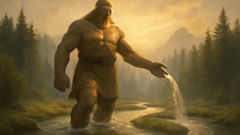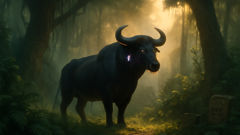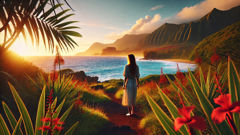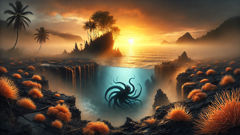Introduction
On the wide rim of the world where the sky dips into the sea, the legend of Kupe begins with a hush and a heartbeat. In the mouths of elders the story is not a bare list of events but a living tide — a landscape of sound and scent and direction: the salt on the lips, the creak of the waka, the geometry of the stars. Kupe stands at the prow of his craft like a statue with blood in its veins. The wind is named, the current is known, and the night sky is read as a long, patient book. He comes from Hawaiki, the homestead of many beginnings, a place of genealogies, intoned names, and the low thrumming of stories that insist on being traced. Some versions of the tale bring in kin and quarrel: the jealous search for a betrothed, the pursuit of mana, or an errant curse that drives a man to seek new shores. Others speak simply of curiosity and a stubborn, human reaching. Yet all versions agree on the voyage: Kupe takes a waka, trusts the cues of sea and sky, and goes where the horizon allows him. He is at once a hero and a cautionary figure — brave enough to challenge the ocean’s moods, wise enough to hear its small warnings, proud enough to cut his name into the map of the world. The sea is not empty: the night is thick with navigational signs, the otolith memory of birds and dolphins, and the slow reveal of sulphur-scented clouds that mark distant land. For the reader who approaches without the chant of the marae, the voyage can be framed as exploration. For those who hold whānau and whakapapa at the centre, it is a founding memory, an origin song that locates people within place. This telling seeks to honor both perspectives — to paint Kupe as navigator, myth-maker, and living ancestor — while keeping a steady hand on respectful depiction. The telling that follows is long and specific: it moves through wind and worry, through uncanny events that suggest the weave of the gods, through the personal and political motives that drive human voyagers. Along the way, place names will appear like beads on a string: islands, straits, reefs, shoals — each name a memory-mark, each memory an anchor. The aim is not to replace the many versions told within iwi, hapū and whānau, but to render an evocative portrait that invites readers into the salt-warmed world where Kupe first saw the line of islands now called Aotearoa, and where, for countless generations, people have continued to walk the land knowing the sea behind them was once a fierce and faithful teacher.
Across the Deep: Kupe's Crossing and the Art of Polynesian Navigation
The sea is a library and the navigator its reader. For Kupe, the ocean was not a blank to be crossed but a patterned text to be deciphered by skill, by memory, and by a kind of hardened attention that hears the world’s small signals and trusts them. The first part of his voyage is a study in ways of knowing: how to follow birds at dawn, how to catch the subtle shift in swell when a distant landmass bends the ocean's skin, how to find a line of cloud which marks the heat rising off a reef. These were not tricks but practiced arts, learned from elders around a fire where stories and star charts were taught by example more than by formula. Kupe’s waka rode the broad shoulders of the Pacific. It was carved long and low, its prow adorned with ancestral faces whose eyes seemed to watch the horizon. The crew — sparse by some accounts, elaborate by others — manned the vessel with the economy demanded by open ocean voyaging: paddles balanced against the deck like resting birds; sails stitched from pandanus and flax, their seams rolled tight against wind. The navigator’s tools were not only physical. A mnemonic net of songs, chant-lines and sequences guided decisions at night. Each verse encoded which star to follow during a particular month, which bird's flight to trust at twilight, how to mark time against the slow migration of cloud. Kupe listened to this chorus and learned to translate its rhythms into direction. The wind's temperament told him where the subtler currents would gather food and birds; the spray's coldness told of the ocean’s differing temperatures. When the waka moved deeper into the open, the predictable signs — fishbones of land-borne weeds, the stink of seabird colonies, the way particular cloud-streaks amassed — were Kupe’s compass. There are moments in the telling where the myth breathes a little differently: some narrations place Kupe in flight, hunted or chasing a rival for a wronged woman; others give him a different kind of impetus, an obligation to kin seeking new places to settle. Yet the seam of all versions is the crossing itself, and the way it tests both vessel and soul. Nights at sea are long and strange. Stars wheel with indifferent slowness; waves insist on forgetting the hour. Kupe and his people sang to keep rhythm, songs at once practical and prayerful. The waka's wake writes a thin white memory on the black skin of the ocean as if to say: we have been here. As dawn pooled, Kupe read the birds that returned to the sea each morning, their routes inflecting the possible closeness of land. He marked the taste of the spray and the moon’s tilt as if they were chapters. And then, in the hush between two tides, a change: a cloudbank smeared with a different color; the water shifting with a new kind of current; fish of unfamiliar pattern. The signs were small, but Kupe's attention was a magnifier. The crew tightened the sail. He ordered the waka’s course by an angle that seemed like a reckoning. The sense of approach is rarely loud in maritime myths. Land rises like a remembered dream, often first in scent or in the way birds cast themselves like accents on the sky. When the outline finally appears it is both immediate and patient: a smear of darker weather against the horizon, then ridges that suggest a backbone. With land comes a new vocabulary: reefs to skirt, bays to examine, rivers that may feed a people. For Kupe, the first sighting of those islands was a complex moment of triumph and unease. To find land is to find potential — food, shelter, space for a new lineage — but it is also to acknowledge the otherness of a place already alive with its own spirits. Many versions of the tale insist on a dramatic recognition scene: Kupe names the first landmark, speaks the first place-name aloud, and thereby claims it by the act of naming. The act of naming is more than possession; it is a ritual that ties human memory to place and sings the land into narrative. Kupe's voice, in the retellings, fills the silence with names that survive in the landscape as markers of the myth itself, currents of story that ripple through generations. There are moments of wonder and violence in the story. Some tellings include encounters with giant sea creatures, with taniwha who guard passages, or with natural phenomena that the voyagers interpret as signs from the gods. Kupe may engage these forces, sometimes by force of arms, sometimes by rites intended to appease or invite. Each element in the story is a way of dramatizing the precariousness of early voyaging and the respect it demanded. Kupe's landing transforms the sea into a threshold: this is the place where his waka rests and where his story will thread into the longer stories of iwi who would eventually claim kinship with him. The islands themselves become characters: sheltered bays that could feed many mouths, cliffs that hear the sea like a constant drum, rivers whose mouths shape estuaries and invite settlement. This is a voyage told in both practical and poetic detail — the craft of navigation presented in parallel with images of human longing, courage, and the naming power of arrival. In the telling that follows, place names, star-lines, and the small, learned tricks of navigators are woven into a narrative that honors the depth of Māori knowledge while drawing readers into the epic scale of open-ocean voyaging.
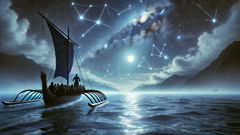
Naming the Land: First Encounters, Place-Names, and the Shape of Memory
When Kupe's eyes first fixed on those islands they were not yet called by the names that anchor them in later maps. The act of seeing and naming in many versions of the myth is a moment of both revelation and responsibility. Names function as mnemonic anchors: they fix sequences of travel, commemorate events, and fold human life into the geographic. Kupe moves through a landscape that will become, in time, a web of names that carry memory. How he names places varies by telling, but the essential pattern repeats: a discovery leads to a name, the name to a story, the story to lineage. Many place-names are born from a single action or event. Perhaps Kupe lands on a bay where he sees an animal previously unknown to him, and he names the place after that sight. Perhaps a storm lashes the shoreline and he names the reef after the sound of breaking waves. In other versions the names memorialize people: relatives, children, or ancestors, whose names become tied to places as if to extend their presence into the land itself. There are also names given in grief and anger, names that warn future travelers and names that celebrate abundance. These practices reveal a human geography rooted in lived experience rather than abstract coordinates. This human geography is especially visible in coastal places, where the shorelines and sounds are immediate and the resources available — fish, shellfish, fresh water — can sustain a community. Kupe’s landing is not the final act of arrival but the first line in a long negotiation with land already full of other presences. In the telling tradition, the land is not an empty stage to be occupied; it is a living, breathing entity that notices and remembers. Kupe’s party meets the island with both practical assessment and ritual acknowledgement. They gather shellfish, test soil, drink from streams — acts that register the land’s offerings — and they also perform karakia, chants to the gods, to acknowledge the spiritual dimensions of place. In some retellings there are more difficult encounters: signs of other people, traces of habitation, or natural phenomena interpreted as warnings. Such scenes complicate the myth’s founding claim and emphasize that arrival is rarely solitary. Kupe's naming begins a ritual economy where names anchor claims of belonging across generations. The names he gives appear in oral genealogies and in the songs of people who will, in older times, narrate their origins at the marae. These names become both cultural inheritance and practical guide: they signal where to fish, where to navigate, where to settle. The story thus acts as instruction — a way to preserve ecological knowledge alongside cultural memory. There are stories of Kupe's direct interactions with the living land: he chases whales into bays whose names thereafter contain the echo of their presence; he finds towering trees and calls them by names that reflect both their scale and status. Natural features are given human attributes in the myth — bays that welcome, cliffs that judge, rivers that hum. In some versions of the tale, Kupe's coming is followed by an assessment of suitability: which places can sustain gardens, which inlets offer shelter from southerlies, which headlands mark currents to avoid. These pragmatic concerns are entwined with the spiritual: karakia are used to bless planting sites and to ask permission from the taniwha, beings that sometimes act as guardians of particular waterways. The relationship between people and place in these stories is reciprocal — land gives, and people care in return; in this reciprocity lives a kind of stewardship that will be developed across generations. Kupe’s narrative also contains quieter human moments that deepen the myth's emotional texture. Alone on a point of land, he may look back over the dark ribbon of sea and feel the weight of separation. Stories sometimes mention a pause in which Kupe thinks of Hawaiki, of the faces he left behind, of the reasons that set him on the ocean. It is in these pauses the tale attains universality: exploration is not only about new maps but about leaving and the ache that comes with leaving. The oral tradition preserves the tone of this ache with songs that are at once directive and elegiac. Kupe's arrival is thus a many-faceted event: it is triumph and assessment, blessing and a delicate beginning of settlement. The place-names he gives, and the rituals that accompany them, stitch his story into the land and turn the newly seen islands into remembered home. For generations, Maori iwi would recall Kupe as an ancestor figure and a source of navigational lore; the names he bestowed function both as cultural signposts and as living reminders that human presence in Aotearoa emerges from the dialogue between sea, sky, and people.
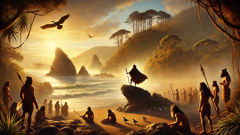
Conclusion
Legends like Kupe’s are not fossils locked in time; they are living narratives that continue to shape identity, to teach practical knowledge and to remind communities of ongoing relationships with land and sea. The myth of Kupe’s voyage preserves the memory of skillful Polynesian navigation, the artistry of reading the sky and swell, and the human courage required to cross great distances in a fragile craft. It also, crucially, records the ethical layers that accompany discovery: naming as claim, ritual as acknowledgement, and the recognition that land is not blank but full of stories and spirits. In contemporary Aotearoa, Kupe's story is part of a wider conversation about how histories are told and whose voices are privileged. Whakapapa and oral tradition remain vital to iwi and hapū, while scholars and storytellers seek to present the myth in ways that respect cultural ownership and the pluralities of version. For readers drawn by the romance of oceanic exploration, the legend offers vivid images — the waka cutting through moonlight, the star-lines like silver ropes, the first naming of a reef. For those interested in human resilience, Kupe’s voyage stands as a testament to the skill, courage, and communal knowledge that made Polynesian voyaging one of the great achievements of maritime history. The tale is not a simple claim of priority; it is a complex knot of memory, ritual, and practical wisdom that binds people to place. Its endurance matters not only because it tells how land was first seen but because it reveals how humans invest meaning into landscape. In remembering Kupe, communities remember a mode of dwelling that is reciprocal and attentive, one that still matters when modern coastlines are reimagined through maps and city plans. The sea that Kupe knew is the same sea that continues to teach, to nourish, and to warn. When modern readers listen carefully, the legend’s practical details — the signs of land, the waybirds behave, the texture of sway and swell — can be read as a testimony to sophisticated navigational science encoded in song and memory. Above all, the myth of Kupe’s voyage invites us to consider how stories shape place. Names, chants, and the act of telling sustain cultural continuity, and the very human act of narrating voyages binds past, present and future into a single, living archipelago. To follow Kupe on this journey is to learn the art of attentive seeing, of naming with humility, and of meeting the world as something that remembers us back.

